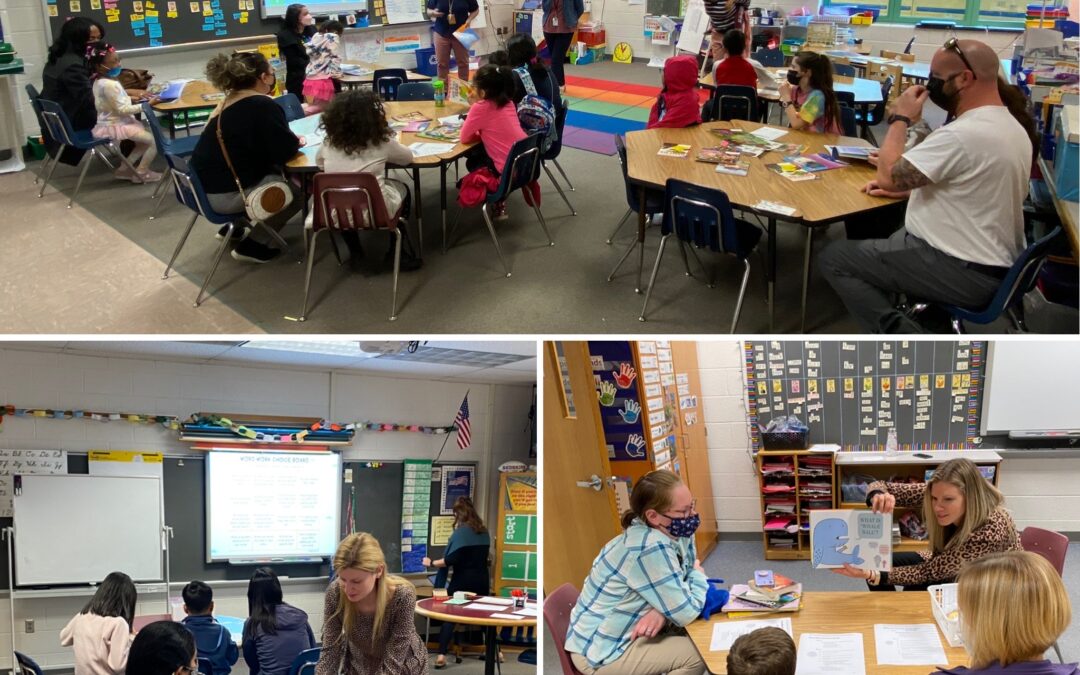Josh Douds, Jennifer Killingsworth, and Rachel Forte, Centreville Elementary School (Centreville, Virginia)
Throughout the upcoming months, we will be running a Q&A blog series that features GSNN partners describing best practices and lessons learned on topics tied to each of the impact systems in the GreenPrint. Q&As for May and June focus on the Climate and Culture system.
This is the fifth blog in the series.
Centreville Elementary School serves a diverse school community in Northern Virginia. Describe how the school has created an inclusive environment that reflects the community it serves.
At Centreville Elementary School (CES), inclusivity is embedded into all aspects of our school culture. The needs and diversity of the community are always considered when making schoolwide decisions. We have systems in place to take a proactive approach. Our professional staff learning this year was a double track agenda using equity and instruction as a focus. We intentionally planned structures for discussion using the book, Blind Spot, to provide staff the opportunity to engage in vulnerable conversations. We connected this to our yearlong learning, using Cultivating Genius, an equity framework for instruction, to embed identity, criticality, intellect, and joy into skill-based learning for all students. Our staff explored their identities and engaged in discussion while hearing others’ perspectives to confirm, change, or deepen understanding.
Hiring is critical for us as we look at our community and its needs. We consider which qualified candidates would be the best fit for our community. We want to ensure all families have positive and welcoming interactions from registration to sixth-grade graduation. We reflect as an administration team and gain feedback in structured and anecdotal ways to continually ensure this is the experience our students, staff, and families feel on a consistent basis.
Our school has also worked very diligently to create a positive relationship with the community through engaging in a collaborative partnership. This is an ongoing process, and we are always seeking new and innovative ways to enhance the partnership. We have established a variety of community/family events and activities to cultivate an inclusive culture. A few of our events include:
- Family field trips
- Family STEAM nights
- PTA/school fairs/carnivals
- Welcome walks
- Community collaborative learning teams
- Family math/literacy/social-emotional nights
- Family picnics
- Community clean-up days
What policies and programs does Centreville have in place to ensure multiple perspectives and voices are heard when making decisions that impact the school community?
At CES, we believe that it’s our job to serve the community. To ensure that we are doing this we encourage and seek feedback from diverse stakeholders. We gather critical feedback in a variety of formats. Community walk-throughs, community professional learning committees, town halls, principal coffees, surveys, and language-specific community conversations are a few platforms we use to ensure multiple perspectives and voices are coalesced when making decisions. In addition to structured platforms, we have informal and formal daily conversations and meetings with parents about ways to support student success. This may include academics, social and emotional wellness, or any other concern that is brought to us.
Family involvement is a big part of Centreville’s culture. Describe some of the methods the school uses to communicate with families, many of whom speak multiple languages.
Communication is key to successful family involvement. At CES, we use a variety of media to communicate with parents.
- Weekly family newsletters are sent home through an online program called GovDelivery. This site doesn’t have translation built in, but each week we provide directions on how to use the browser settings to change the language.
- Our schoolwide quick and emergency communication is done using an online program called SchoolMessenger. This site is very effective because student home language translations are built in. A text component is also embedded into this program to facilitate faster connections with families.
- We use an application called Talking Points to collaborate via text messaging in our student families’ home languages.
- All written communications are translated into our student families’ home languages.
Describe some of the ways in which Centreville engages student families in sharing their cultures and traditions in the classroom and across the broader school community.
Our resource team (ESOL, literacy coach, media specialist) supports teachers with choosing and planning inclusive, interactive read alouds to incorporate into daily lessons. Next steps for growth include infusing cultures and traditions into all areas of the day, from morning meeting to all academic content areas. Multicultural nights have been a part of our school culture as an opportunity to come together to celebrate the culture and diversity represented in our student population. We are focused on reenergizing and bringing events back to CES post-pandemic.
What kinds of opportunities does Centreville offer its students to learn about different cultures, traditions, experiences, and perspectives in the local and/or global community?
Learning about different cultures, traditions, experiences, and perspectives is embedded and consistently infused into daily instruction. Teachers collaborate with one another during weekly team meetings to intentionally formulate lessons that encompass diverse perspectives and ideas. This includes seeking out diverse read aloud books, podcasts, or videos. Teachers frequently have classroom guests who teach students about other cultures and capitalize on the diversity within the classroom. Teachers intentionally plan for instruction that encompasses students understanding and sharing about their own identities. When planning, teachers often ask themselves, “How will this lesson help students to learn something about themselves or about others?” which connects to Gholdy Muhammed’s culturally and historically responsive literacy framework.
An especially exciting opportunity is our school’s partnership with Costa Rica through the Global Classroom Project. Students in various grade levels collaborate with students in Costa Rica to learn about their traditions, experiences, and culture. This authentic global partnership expands past our school’s walls to enrich equitable learning opportunities. We also offer equity coffeehouses for our teachers. This is a dedicated time where they can dive deeply into more inclusive equity frameworks to support the expansion of learning for our students.

